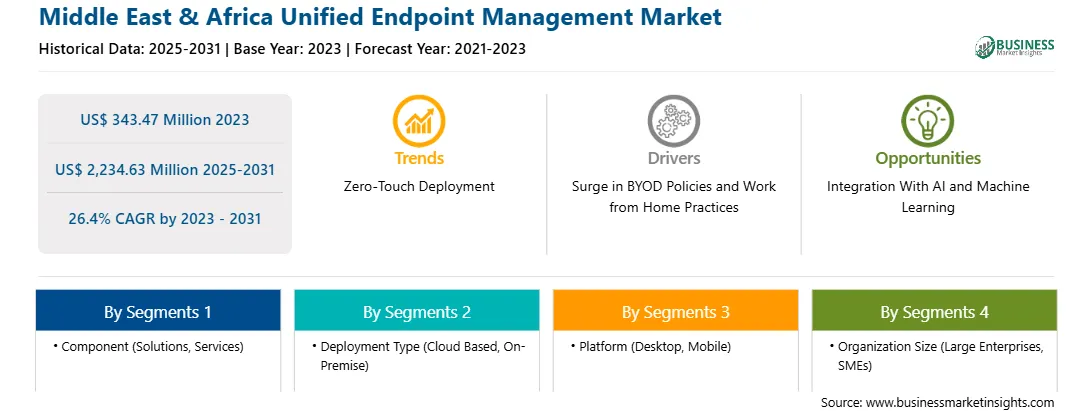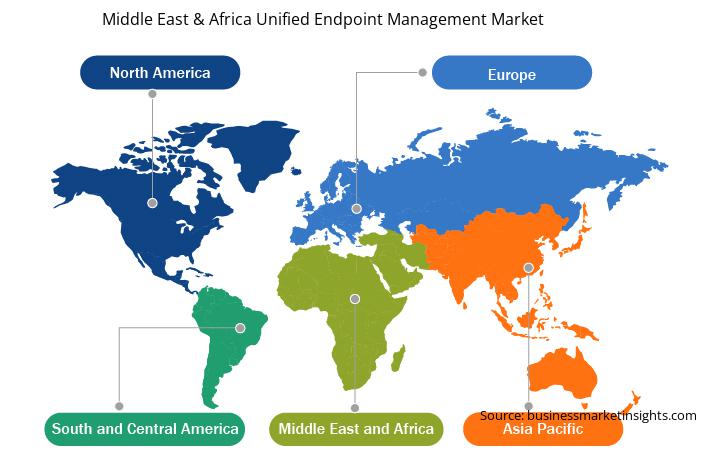Middle East & Africa Unified Endpoint Management Market
No. of Pages: 150 | Report Code: TIPRE00016333 | Category: Technology, Media and Telecommunications
No. of Pages: 150 | Report Code: TIPRE00016333 | Category: Technology, Media and Telecommunications
High Growth Potential in Small and Medium-Sized Enterprise (SME) Sector would drive the Middle East & Africa Unified Endpoint Management Market
Large enterprise customers dominate the unified endpoint management market across various geographies. The complex, large-scale operations, huge number of endpoint devices, prevailing trend of remote work, and fast adoption of advanced solutions are some of the key reasons driving the demand for unified endpoint management solutions and services across large enterprises regionally. In addition, large enterprises are also at the forefront of digital transformation to improve operations and enhance process security. However, small, and medium-sized enterprises (SMEs) are still in the growth stage of adopting advanced technology solutions such as unified endpoint management by replacing traditional endpoint management solutions. The lack of resources and awareness about the potential cost and productivity benefits of unified endpoint management solutions have impacted the adoption to some extent among SMEs. However, with the growing popularity of cloud-based unified endpoint management, SMEs are increasingly investing in such solutions, thus, offering a huge growth opportunity for the market players operating in the Middle East & Africa unified endpoint management market. Key companies such as Citrix Systems, Inc.; VMware, Inc.; and Microsoft Corporation are offering cloud-based UEM solutions/subscriptions at competitive prices for SMEs to increase their revenue and market share. Moreover, the rising trend of digital transformation among these enterprises to improve business processes, enhance productivity, and reduce costs will boost the adoption of unified endpoint management solutions and services among SMEs, thus, providing potential growth opportunities to the market players during the forecast period of 2022 to 2028. Such initiatives would drive the growth of Middle East & Africa unified endpoint management market during the forecast period.
Middle East & Africa Unified Endpoint Management Market Overview
The Middle East & Africa unified endpoint management market is segmented into South Africa, Saudi Arabia, the UAE, and the Rest of Middle East & Africa. The Gulf countries are economically advanced, while the African countries still have to balance their economic conditions. The Gulf Countries Council (GCC) plans various strategies to encourage collaboration, enhance innovation, streamline intermodal transportation, and improve national economies. The EU's introduction of GDPR is creating issues for companies in the region, majorly for SMEs. The government authorities are on the path to pursue economic growth programs to accelerate employment and diversify GDP in addition to oil-and-gas production. As the private sector grows, SMEs are heavily hit by the cost of federal regulatory compliance. In Middle East, it is mandatory for businesses to comply with GDPR rules to avoid cyber risks. As per the assistant general counsel for corporate external and legal affairs for the Middle East & Africa at Microsoft, there are nearly 160 GDPR requirements for how business gathers, stores, and uses personal information to mandate a 72-hour notification of personal data breaches. The implementation of GDPR compliance in the Middle East & Africa is projected to affect the utilization of unified endpoint management to ensure data security. Boldon James, Titus, and a few companies have adopted unified endpoint management tools. In July 2019, Spire solutions became a distributor of Titus to cater to data protection and unified endpoint management requirements in the region. Similarly, in July 2017, StarLink, the security-specialized Value-Added-Distributor (VAD), partnered with Boldon James. The company has expanded its sales in Middle East through this partnership. Such initiatives would drive the growth of Middle East & Africa unified endpoint management market during the forecast period. Various verticals, including BFSI, energy, healthcare, and government, are adopting endpoint management as they possess an enormous amount of sensitive and secret data. Additionally, the network security industry in the Middle East & Africa is expanding because the Bring Your Own Device (BYOD) and Work from Home (WFH) scenarios are becoming prevalent during the COVID-19 pandemic. Based on the Aruba Networks report, in 2021, 69% of the organizations in Middle East adopted some form of BYOD. Similarly, the network security business in the region witnesses implementation difficulties because of the increasing complexity of establishing IT security infrastructure on operational technology (OT) and supervisory control and data acquisition (SCADA). The network of businesses in Middle East has also been threatened by the expansion of remote working practices due to the effects of COVID-19 pandemic. Organizations are implementing countermeasures and working with security suppliers to handle the situation successfully. Hence, the expanding BYOD practice across the region is anticipated to create lucrative opportunities for the Middle East & Africa unified endpoint management market over the forecast period.

Strategic insights for the Middle East & Africa Unified Endpoint Management provides data-driven analysis of the industry landscape, including current trends, key players, and regional nuances. These insights offer actionable recommendations, enabling readers to differentiate themselves from competitors by identifying untapped segments or developing unique value propositions. Leveraging data analytics, these insights help industry players anticipate the market shifts, whether investors, manufacturers, or other stakeholders. A future-oriented perspective is essential, helping stakeholders anticipate market shifts and position themselves for long-term success in this dynamic region. Ultimately, effective strategic insights empower readers to make informed decisions that drive profitability and achieve their business objectives within the market.

| Report Attribute | Details |
|---|---|
| Market size in 2022 | US$ 270.61 Million |
| Market Size by 2028 | US$ 1,170.31 Million |
| Global CAGR (2022 - 2028) | 27.6% |
| Historical Data | 2020-2021 |
| Forecast period | 2023-2028 |
| Segments Covered |
By Component
|
| Regions and Countries Covered | Middle East and Africa
|
| Market leaders and key company profiles |
The geographic scope of the Middle East & Africa Unified Endpoint Management refers to the specific areas in which a business operates and competes. Understanding local distinctions, such as diverse consumer preferences (e.g., demand for specific plug types or battery backup durations), varying economic conditions, and regulatory environments, is crucial for tailoring strategies to specific markets. Businesses can expand their reach by identifying underserved areas or adapting their offerings to meet local demands. A clear market focus allows for more effective resource allocation, targeted marketing campaigns, and better positioning against local competitors, ultimately driving growth in those targeted areas.

Middle East & Africa Unified Endpoint Management Market Segmentation
The Middle East & Africa unified endpoint management market is segmented into component, deployment type, platform, organization size, end-user, and country.
Based on component, the Middle East & Africa unified endpoint management market is segmented into solutions and services. The solutions segment held the larger market share in 2022.
Based on deployment type, the Middle East & Africa unified endpoint management market is segmented into cloud based and on-premise. The cloud based segment held the larger market share in 2022.
Based on platform, the Middle East & Africa unified endpoint management market is segmented into desktop and mobile. The desktop segment dominated the market share in 2022.
Based on organization size, the Middle East & Africa unified endpoint management market is segmented into SMEs and large enterprises. The large enterprises segment dominated the market share in 2022.
Based on end-user, the Middle East & Africa unified endpoint management market is segmented into BFSI, government and defense, healthcare, IT and telecom, automotive and transportation, retail, manufacturing, and others. The IT and telecom segment dominated the market share in 2022.
Based on country, the Middle East & Africa unified endpoint management market is segmented into South Africa, Saudi Arabia, the UAE, and the Rest of Middle East & Africa. Saudi Arabia segment dominated the market share in 2022.
Citrix Systems, Inc.; IBM Corporation; Ivanti; MICROLAND LIMITED; Microsoft Corporation; STEFANINI; and Zoho Corporation Pvt. Ltd. are the leading companies operating in the Middle East & Africa unified endpoint management market.
The Middle East & Africa Unified Endpoint Management Market is valued at US$ 270.61 Million in 2022, it is projected to reach US$ 1,170.31 Million by 2028.
As per our report Middle East & Africa Unified Endpoint Management Market, the market size is valued at US$ 270.61 Million in 2022, projecting it to reach US$ 1,170.31 Million by 2028. This translates to a CAGR of approximately 27.6% during the forecast period.
The Middle East & Africa Unified Endpoint Management Market report typically cover these key segments-
The historic period, base year, and forecast period can vary slightly depending on the specific market research report. However, for the Middle East & Africa Unified Endpoint Management Market report:
The Middle East & Africa Unified Endpoint Management Market is populated by several key players, each contributing to its growth and innovation. Some of the major players include:
The Middle East & Africa Unified Endpoint Management Market report is valuable for diverse stakeholders, including:
Essentially, anyone involved in or considering involvement in the Middle East & Africa Unified Endpoint Management Market value chain can benefit from the information contained in a comprehensive market report.